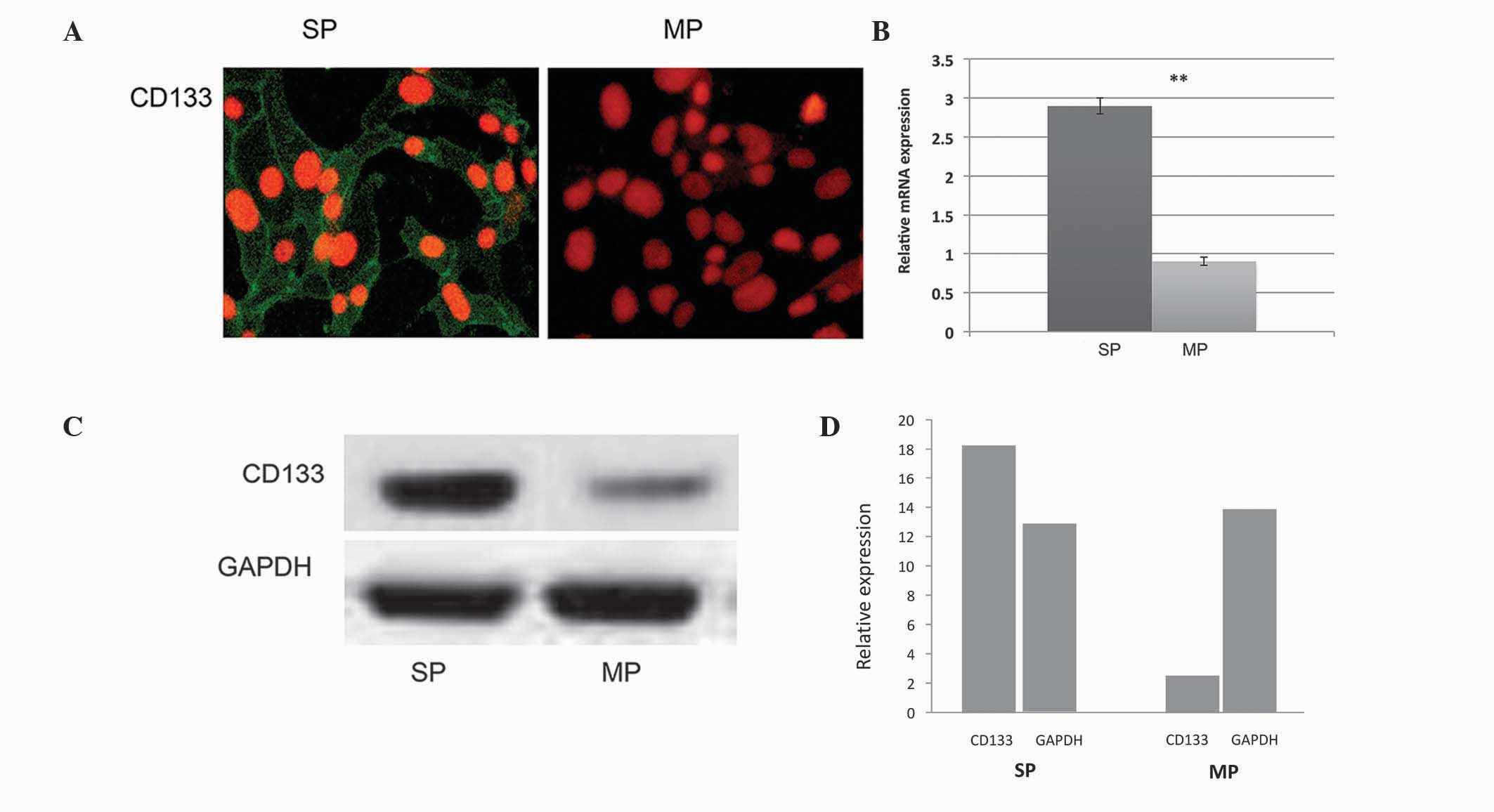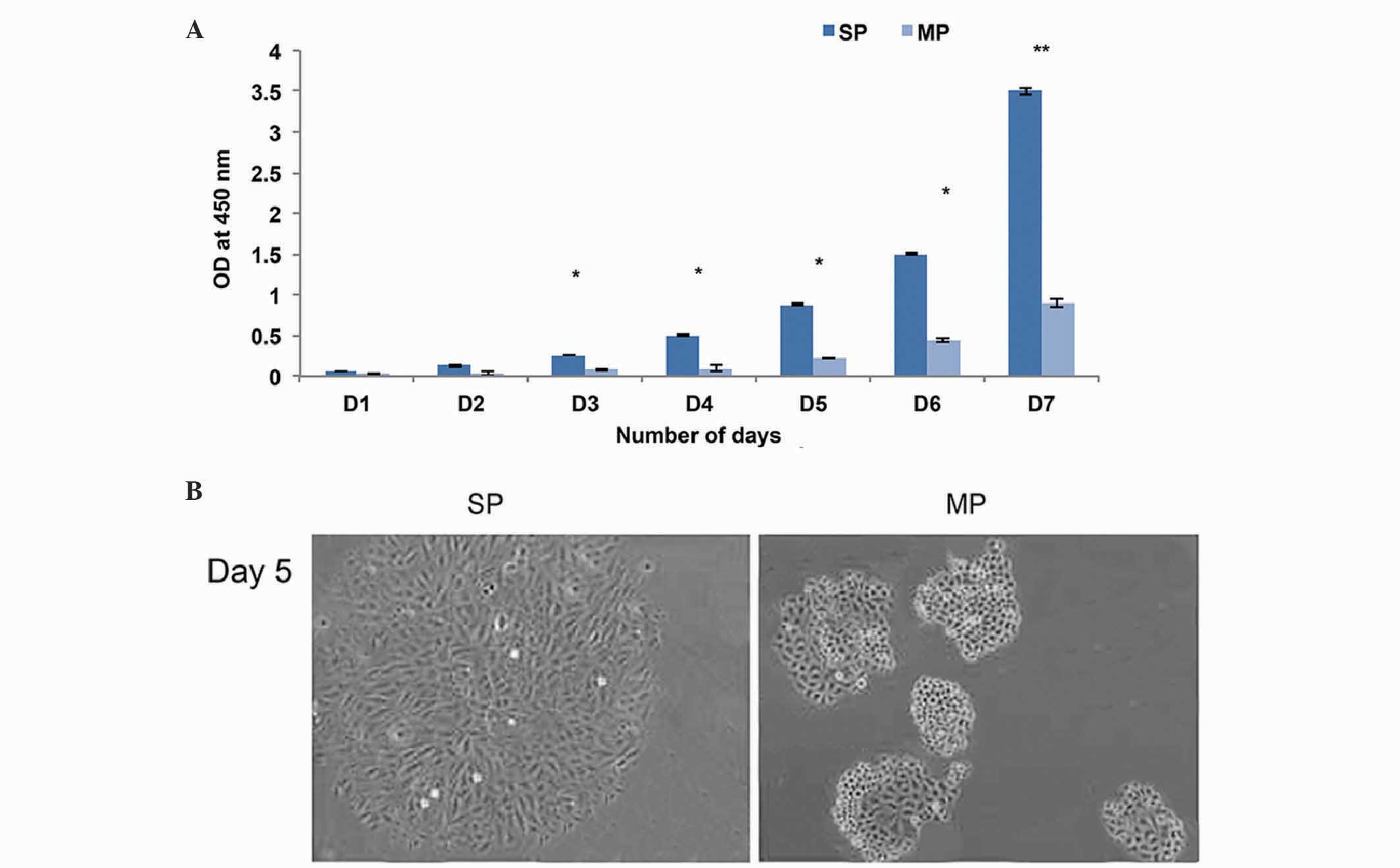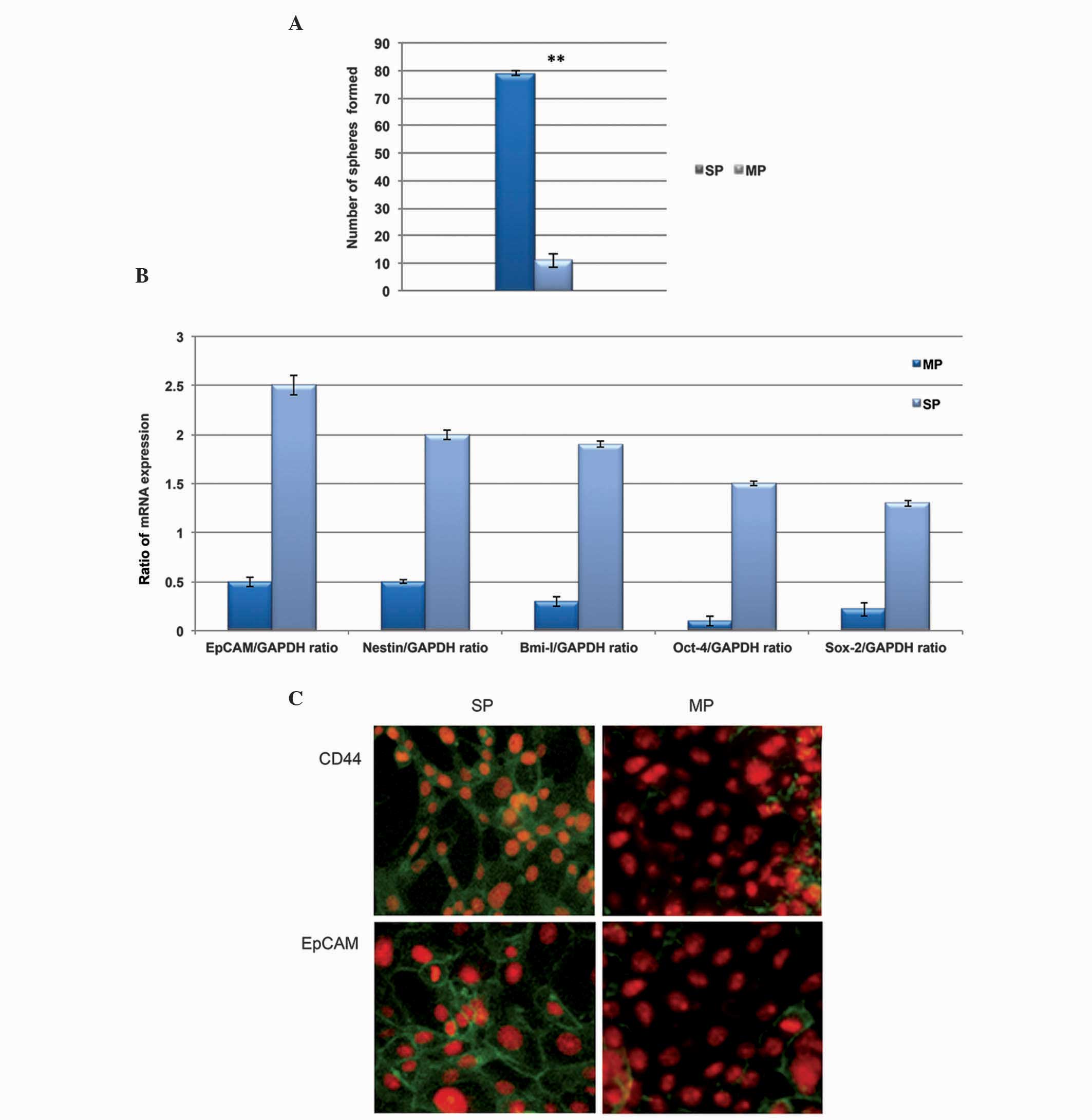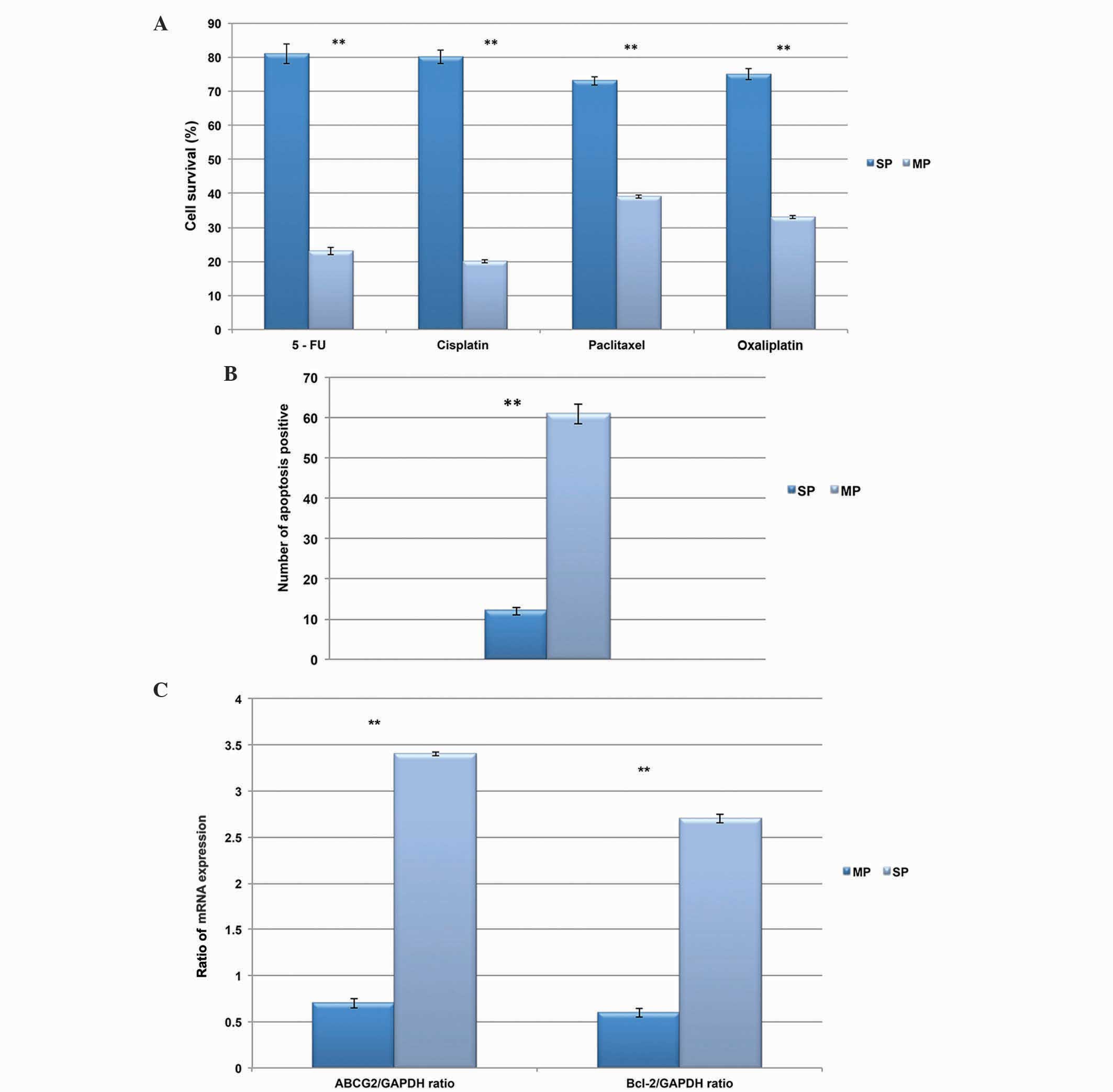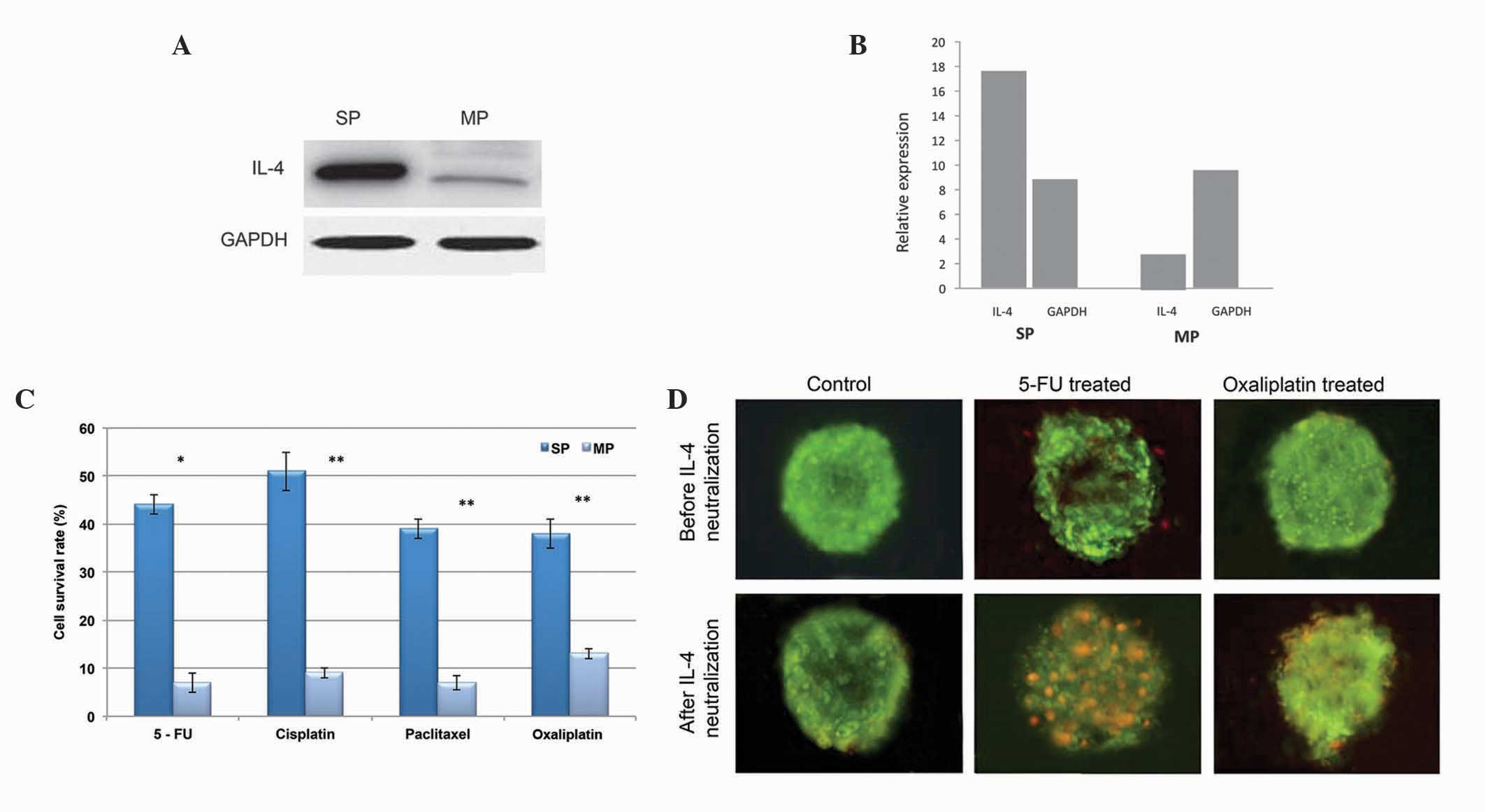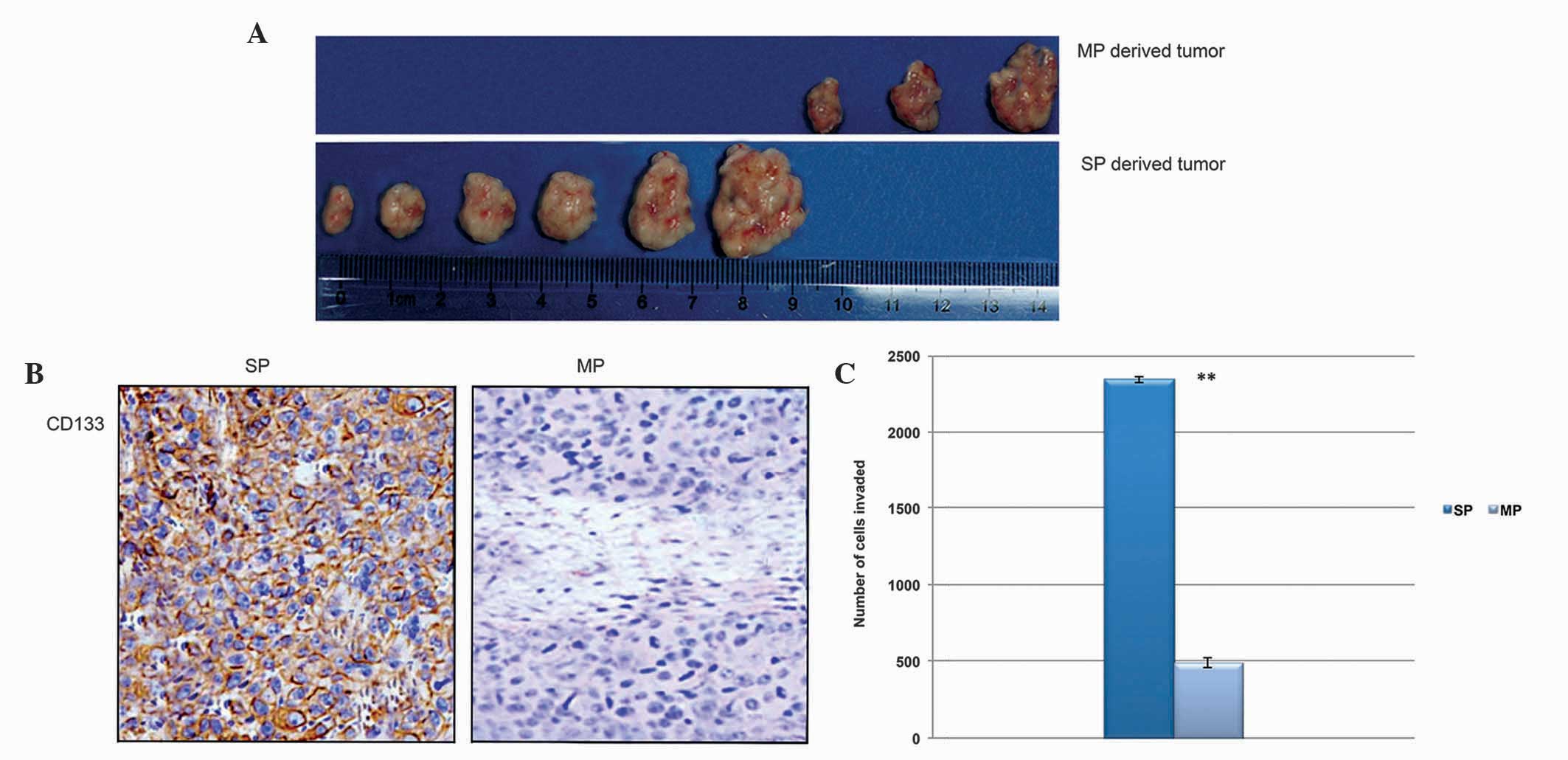Production of interleukin‑4 in CD133+ cervical cancer stem cells promotes resistance to apoptosis and initiates tumor growth
Retraction in: /10.3892/mmr.2016.5732
- Authors:
- Published online on: April 27, 2016 https://doi.org/10.3892/mmr.2016.5195
- Pages: 5068-5076
-
Copyright: © Liu et al. This is an open access article distributed under the terms of Creative Commons Attribution License.
Abstract
Introduction
The second most common type of female malignancy is uterine cervical cancer, which accounts for >30% of mortality rates. Several studies have reported that the association with human papillomavirus (HPV-16) infection and the expression of its oncoprotein, E6, are crucial for progression and development of cervical cancer (1–3). The presence of HPV-16 and HPV-18 are potentially highly carcinogenic and, thus are categorized as high-risk for cervical cancer (4). As in other types of solid tumor, the presence of a small population of cancer stem cells (CSCs) in cervical cancer is a major implication in cancer therapy and the complete eradication of refractory tumors. According to the CSC theory, these cells exhibit high levels of resistance to multi-drug treatment, as they possess increased expression of ATP-binding cassette (ABC) transporters (5). In addition, they have a reduced rate of apoptosis, increased DNA repairing capacity and rapid proliferation rate (6). Previous studies have reported that the secretion of interleukin (IL-4) protects CSCs from apoptosis, and thereby it promotes the CSCs survival rate (7,8). IL-4 is produced via autocrine secretion in the T cell response, which has been shown to upregulate the anti-apoptotic and cell cycle mechanism in cancer cell lines (9,10). Considering these previous findings, the present study aimed to evaluate the role of IL-4 in the chemoresistance and apoptotic resistance properties of cervical CSCs, which are positive for the stem cell surface protein, cluster of differentiation (CD)133. The present study aimed to establish the molecular basis of the resistance of cervical cancer stem cells to apoptosis, and to multi-drug treatment.
Materials and methods
Cancer samples and cell culture
Cervical cancer tissue samples were obtained from patients during surgery in the Department of Gynecology, The Affiliated Zhongshan Hospital of Dalian University (Dalian, China). Samples were collected via punch biopsies from 50 female patients aged 26–37 years old, and were characterized as follows: 15 poorly differentiated squamous cell carcinoma samples; 25 high-grade squamous intraepithelial lesion samples and 10 well-differentiated squamous cell carcinoma samples. Corresponding control non-malignant cervical epithelial tissues were obtained from 15 healthy individuals, aged 24–39 years old, which were collected during surgery for hysterectomy. All participants provided written consent to participate in this study. Tissue and information were collected in accordance with the ethical principles of and under ethics committee approval by The Affiliated Zhongshan Hospital of Dalian University. The obtained cancer tissues were washed several times and incubated in Dulbecco's modified Eagle's medium (DMEM)-F12 medium (Sigma-Aldrich, St. Louis, MO, USA) supplemented with high doses of penicillin/streptomycin (100 IU/ml and 100 µg, respectively; MP Biomedicals, Santa Ana, CA, USA) and amphotericin B (2.5 µg/ml; MP Biomedicals) overnight at 37°C. Tissue dissociation was performed by enzymatic digestion (20 mg/ml collagenase II; Invitrogen; Thermo Fisher Scientific, Inc., Waltham, MA, USA) for 2 h at 37°C.
Following tissue dissociation and centrifugation (530 × g; 5 min at room temperature), the cells obtained were cultured in serum-free medium containing 50 mg/ml insulin (Invitrogen; Thermo Fisher Scientific, Inc.), 100 mg/ml apo-transferrin (Lee Biosolutions, Inc., Maryland Heights, MO, USA), 10 mg/ml putrescine (MP Biomedicals), 0.03 mM sodium selenite (Sigma-Aldrich), 2 mM progesterone (EMD Millipore, Billerica, MA, USA), 0.6% glucose (Sigma-Aldrich), 5 mM HEPES (Merck Millipore, Darmstadt, Germany), 0.1% sodium bicarbonate (Merck Millipore), 0.4% bovine serum albumin (BSA; Sigma-Aldrich), glutamine (Merck Millipore) and antibiotics, dissolved in DMEM-F12 medium and supplemented with 20 mg/ml epidermal growth factor (EGF; Merck Millipore) and 10 mg/ml basic fibroblast growth factor (bFGF; Merck Millipore).
Fluorescence-activated cell sorting (FACS) analysis
The cells (1×106 cells/ml)were cultured in DMEM with 10% fetal bovine serum (FBS; Sigma-Aldrich), supplemented with antibiotics, and maintained in T-75 flasks (Sarstedt, Nümbrecht, Germany) at 37°C in a humidified 5% CO2 and 95% air atmosphere. On reaching 90% confluence, the cells were removed from the culture flask using Trypsin-EDTA (0.25% 53 mM EDTA; Lonza Group AG, Basel, Switzerland) and suspended in 10% DMEM. The number of cells were counted using a Bright-Line hemocytometer (Hausser Scientific, Horsham, PA, USA). The cells were incubated with rabbit anti-CD133 fluorescein isothiocyanate (FITC)-conjugated antibody (dilution, 1:500; cat. no. orb15325; Biorbyt, Cambridge, UK) for 30 min. Following washing with phosphate-buffered saline (PBS), the cells were further counterstained with propidium iodide (PI; EMD Millipore). FACS was then performed to sort cells into sorted side population (SP) and main population (MP) cells, using a FACSAria II flow cytometer (BD Biosciences, Franklin Lakes, NJ, USA).
Reverse transcription-quantitative polymerase chain reaction (RT-qPCR)
Total RNA was extracted from the cells, and complementary DNA was prepared using a Reverse Transcriptase kit (Fermentas; Thermo Fisher Scientific, Inc.). The amplification of specific RNA was performed in a 20 µl reaction mixture containing 2 µl of cDNA template, 1X IQ Supermix with SYBR-Green PCR mastermix (Bio-Rad Laboratories, Inc.) and 0.4 µM primers. RT-qPCR analysis was subsequently performed on an iCycler IQ real-time detection system (Bio-Rad Laboratories, Inc., Hercules, CA, USA), using PCR master mix. Reactions were performed in triplicate. The primer sequences used were as follows: ABCG2, forward 5′-GGATGAGCCTACAACTGGCTT-3′ and reverse 5′-CTTCCTGAGGCCAATAAGGTG; octamer-binding transcription factor-4 (OCT4), forward 5′-TCGAGAACCGAGTGAGAGGC-3′ and reverse 5′-CACACTCGGACCACATCCTTC-3′; epithelial cell adhesion molecule (EpCAM), forward 5′-CTGCCAAATGTTTGGTGATG-3′ and reverse 5′-ACGCGTTGTGATCTCCTTCT-3′; (sex determining region Y)-box 2 (Sox2), forward 5′-CACACTGCCCCTCTCACACAT and reverse 5′-CATTTCCCTCGTTTTTCTTTGAA-3′; Nestin, forward 5′-AGAGGGAGGACAAAGTCCCT-3′ and reverse 5′-CACTTCCTCAGACTGCTCCA-3′; B-cell-specific Moloney murine leukemia virus insertion site-1 (Bmi-1), forward 5′-CTCCCAACTGGTTCGACCTT and reverse 5′-GGTTTCCATATTTCTCAGT-3′; CD133, forward 5′-TCTTGACCGACTGAGAC-3′ and reverse 5′-ACTTGATGGATGCACCAAGCAC-3′ (11-13); B cell lympoma (Bcl)-2, forward 5′-ACACTGTTAAGCATGTGCCG-3′ and reverse 5′-CCAGCTCATCTCACCTCACA-3′; GAPDH, forward 5′-TCTGCTCCTCCTGTTCGACA-3′ and reverse 5′-AAAAGCAGCCCTGGTGACC-3′. These were supplied by Shanghai ShineGene Molecular Biotech, Inc. (Shanghai, China). GAPDH was used as a housekeeping gene. The parameters used to set the qPCR reactions were as follows: Initial denaturation at 95°C for 15 sec, annealing at 58°C for 45 sec and extension at 60°C for 30–45 sec (35 cycles). The relative expression values of three independent experiments were determined in accordance with a previous study (14).
In vitro proliferation assay
The SP and MP cells were seeded in a 96-well plate at 2×106 cells/well, and were cultured in a 37°C, 5% CO2 incubator, with each group set up in triplicate. Cell proliferation activity was measured every day for 7 days. Each well was supplemented with Cell Counting Kit-8 (CCK-8) solution (10 µl; Sigma-Aldrich) and incubated in the CO2 incubator for 2–3 h. The optical density (OD) was determined at 450 nm using a Synergy H1 microplate reader (Bio-Tek Instruments, Inc., Winooski, VT, USA). The resulting data were used to construct graphs of cell growth, based on the mean value of OD450 and standard deviation values for each well.
Western blot analysis
For western blot analysis, proteins were extracted from SP and MP cells. A total of 20 mg of cells were lysed in pre-cooled RIPA buffer (Pierce Biotechnology, Inc., Rockford, IL, USA) containing phosphatase inhibitors (Phosphatase Inhibitor Cocktails Set II; Merck Millipore), protease inhibitor tablets (cOmplete; Roche Diagnostics GmbH, Mannheim, Germany) and 2.5 mM dithiothreitol (Sigma-Aldrich) as reducing agent. The lysate was incubated on ice for 30 min, combined with vortexing every 10 min. Cell lysates were clarified of cell debris by centrifugation at 14,000 × g for 5 min through a QIAshredder homogenizer spin column (Qiagen GmbH, Hilden, Germany). The samples were suspended in 5X loading buffer (Fermentas; Thermo Fisher Scientific, Inc., Pittsburgh, PA, USA), denatured at 95°C for 5 min, transferred to ice, then stored at −20°C for subsequent use. Protein concentration was determined using the Bradford method (Quick Start Bradford 1X Dye Reagent; Bio-Rad Laboratories, Inc.). A total of 15 µg total protein was loaded onto 12% polyacrylamide gels for sodium dodecyl sulfate-polyacrylamide gel electrophoresis. Proteins were then transferred onto a nitrocellulose membrane (Schleicher and Schuell GmbH, Dassel, Germany) at 10 V for 45 min using a semi-dry transfer unit (Peqlab Biotechnologie GmbH, Erlangen, Germany). To avoid non-specific binding, membranes were blocked with 5% skim milk protein in PBS/Tween at room temperature for 1 h. The membranes were then treated with the following primary antibodies, diluted in 2% skim milk and PBS/Tween at room temperature for 2 h: Rabbit anti-IL-4 polyclonal (dilution, 1:1,000; cat. no. ab9622; Abcam, Cambridge, MA, USA) and rabbit anti-CD133 (dilution, 1:1,000; cat. no. orb99113; Biorbyt). After washing with PBS, the membranes were incubated with goat anti-rabbit immunoglobulin G with alkaline phosphatase conjugate (dilution, 1:1,000; cat. no. ab6722; Abcam) for 2 h at room temperature. Immunoblots were visualised using an enhanced chemiluminescence kit (Bio-Rad Laboratories, Inc.). Blots were detected and scanned by using a densitometer (Biorad GS-710; Bio-Rad Laboratories, Inc.). Equal concentration of the proteins was loaded per lane and GAPDH is used as a loading control.
Clone formation efficiency
The sorted SP cells and MP cells, at a density of 1,000 cells/ml, were resuspended in tumor sphere medium, consisting of a serum-free 1:1 mixture of Ham's F-12/DMEM, N2 supplement (Thermo Fisher Scientific, Inc.), 10 ng/ml human recombinant bFGF and 10 ng/ml EGF, and were subsequently cultured in ultra-low attachment plates at 37°C for 2 weeks. The SP and MP cells were seeded at a low density (20 cells/liter), and the number of generated spheres measuring >100 lm, were counted following 7 days of culture at 37°C. The resulting values are presented as the average values of three independent experiments.
Tumor cell implantation
Female NOD/SCID mice (Jackson Laboratory, Bar Harbor, ME, USA; body weight, 125–150 g; age, 7–8 weeks) were maintained in pathogen-free vinyl isolators under a 12/12-h day/night cycle at 22±1°C, and had access to sterilized laboratory chow and water ad libitum. Eight mice from each group were used for the present study. The FACS-purified SP and MP CD133+ cells were mixed with Matrigel Matrix (Corning Life Sciences, Tewksbury MA, USA) and administered into these mice by subcutaneous injection (15). Mice were injected once with 5×103 SP cells or 5×104 MP cells in a 500 µl volume, using a 25–26-gauge needle. The density of cells injected and mouse growth were monitored, according to a previously described protocol (15). The tumor volumes were measured according to the following formula: V = 1/2 ab2, in which a represents the long diameter of the tumor and b represents the short diameter of the tumor. After 2 weeks, the mice were sacrificed by carbon dioxide asphyxiation, tumors were harvested and measured, and images were captured with a Nikon D3100 camera (Nikon Corporation, Tokyo, Japan).
Differentiation assay
The differentiation assay was performed, according to a previously described protocol (16). At 16 days following cell sorting, cells at a density of 1×106 cells/ml were cultured in normal RPMI 1640 (Thermo Fisher Scientific, Inc.), and the differentiation ability of the two subpopulations were determined under an Olympus SZX16 microscope (Olympus Corporation, Tokyo, Japan).
Cell resistance assay
The obtained SP and non-SP cells were cultured at 37°C in 96-well plates at a concentration of 1×103 cells/plate. Following culture for 24 h, 5-fluorouracil (5-FU; Sigma-Aldrich) was added to all cultures to a final concentration of 10 µg/ml. The cells were also treated with cisplatin (20 µmol/l; Sigma-Aldrich), paclitaxel (2 µmol/l; Merck Millipore) and oxaliplatin (100 mM; Sigma-Aldrich). The plates were placed in a hatch box for 48 h at 37°C, following which each well was supplemented with CCK-8 (10 µl) solution and incubated for 3 h at 37°C. The mean OD450 value was then calculated. Cell resistance in the two groups was calculated according to the following formula: Cell resistance rate (%) = (experimental group OD450value / control group OD450value) × 100. In addition, half of the cells were pretreated for 24 h with 10 mg/ml anti-IL-4 to neutralize IL-4, and cell viability was determined following treatment with the drugs. Cell viability was determined using a 3-(4,5-dimethylthiazol-2-yl)-2,5-diphenyltetrazolium bromide (MTT) assay. Following treatment, cell lines were seeded in a 96-well plate (1,000 cells per well) and were washed twice with PBS. MTT solution (5 mg/ml) was then added to each well and the plate was incubated for 2 h at 37°C. The lysis buffer (20% SDS and 50% dimethyl formamide) was added, and the cells were incubated overnight at 37°C. The OD of the cell suspension was measured at 570 nm using the Synergy H1 microplate reader.
Invasion assay
The invasiveness of the SP and MP cells were determined using six-well Matrigel invasion chambers (BD Biosciences). The cells were seeded in serum-free medium at a density of 2×105 per insert. The outer wells were filled with DMEM containing 5% FBS, as a chemoattractant, and incubated at 37°C for 48 h. Subsequently, the non-invading cells were removed by swabbing the top layer of the Matrigel with a Q-tip (16). The membrane containing the invaded cells was stained with hematoxylin (Abcam) for 3 min, washed and mounted on slides. The entire membrane containing the invaded cells was counted under an Olympus SZX16 light microscope, using a 40× objective. The values presented in the graph are the average value of three independent experiments.
Immunocytochemical and immunohistochemical analyses
The sorted SP cells and MP cells were seeded into 35 mm culture plates (approximately 100 µl) and maintained in an incubator at 37°C for 3 h, following which 1 ml of 10% DMEM was added. Following overnight incubation, the cells were rinsed with PBS and fixed in 4% paraformaldehyde (Sigma-Aldrich) in 1X PBS for 5 min at 4°C. Following washing with 1X PBS, the cells were blocked with 1% BSA-Tris-buffered saline (BSA-TBS) with RNase (10 µl/1,000 µl of 3% BSA-TBS; Thermo Fisher Scientific, Inc.). Following 1 h incubation at room temperature, the cells were rinsed with PBS and were incubated with primary anti-rabbit CD44 and anti-rabbit EpCAM antibodies in 1% BSA-TBS (1:100; 2 µl/200 µl) overnight at 4°C. Following washing with 1X PBS, the cells were incubated with secondary FITC-conjugated antibody (1:100 in 1% BSA-TBS) at room temperature for 1 h. The cells were washed again with PBS, and PI was added (1 µl/200 µl PBS).
Immunohistochemistry was performed, as described previously (17). Tissue sections were then incubated overnight with the respective primary anti-rabbit CD133 (1:1,000). The reaction was visualized using a streptavidin-biotin-immunoperoxidase system (Dako, Glostrup, Denmark). All sections were then counterstained with hematoxylin. The cells and tissues were viewed under a confocal laser scanning microscope (Leica TCS; Leica Microsystems, Inc., Buffalo Grove, IL, USA). Image analysis and figures were prepared using Adobe Photoshop CS4 (Adobe Systems, Inc., San Jose, CA, USA).
Terminal deoxynucleotidyl transferase dUTP nick end labeling (TUNEL) assay
A TUNEL assay was performed by washing 4% paraformaldehyde-fixed cells on a coverslip once with PBS, followed by permeabilization using 0.5% saponin (Sigma-Aldrich) at room temperature for 30 min. Following a wash with terminal deoxynucleotidyl transferase (TdT) buffer (Roche Diagnostics, Indianapolis, IN, USA), cells were incubated with 0.5 µM biotin dUTP (Roche Diagnostics) and 150 U/ml of TdT (Sigma-Aldrich) in 30 µl of TdT buffer in a humidified chamber at 37°C for 30 min. Following two PBS washes, the cells were incubated with a 1/1,000 solution of streptavidin-conjugated horseradish peroxidase (Roche Diagnostics) in PBS for 10 min at room temperature. Coverslips were then washed for 30 min with three subsequent washes of PBS. Color was developed using TrueBlue peroxidase substrate (KPL, Inc., Gaithersburg, MD, USA), and coverslips were observed under an Olympus SZX16 microscope.
Statistical analysis
Statistical analysis was performed using SPSS v. 17.0 software (SPSS, Inc., Chicago, IL, USA). One-way analysis of variance and Student's t-test were used to determine significant differences between the treatment and the control groups. Data are expressed as the mean ± standard error. P<0.05 was considered to indicate a statistically significant difference.
Results
Purification of cervical cancer stem cells by FACS
Using FACS, 2.3% of the cervical cancer stem cells were purified, which exhibited overexpression of the CD133 stem cell surface protein. The FACS-sorted cervical SP cells were further subjected to immunocytochemistry. As shown in Fig. 1A, the FACS-sorted SP cells exhibited overexpression of CD133, compared with the MP cells. In addition, the RT-qPCR and western blot analyses revealed that the transcriptional regulations of CD133 in the SP cells was significantly upregulated (Fig. 1B–D).
CD133+ cervical CSCs show high levels of tumorigenicity
The FACS-sorted CD133+ SP and MP cells were further subjected to in vitro cell proliferation assays. The CD133+ SP cells underwent rapid cell proliferation, compared with the MP cells (Fig. 2A) and became more confluent on day 7. Furthermore, the morphology of the SP cells were altered, and began to lose their normal appearance after 5 days, with fibroblast-like filaments produced on day 7 (Fig. 2B). However, the MP cell did not exhibit any morphological changes. The sphere formation assay revealed that the CD133+ cells were highly efficient at generating more tumor spheres, compared with the MP cells (Fig. 3A). The present study also evaluated the expression level of stem cell surface genes in the CD13+ cells using RT-qPCR analysis. As shown in Fig. 3B, the transcriptional regulation of stemness genes, including Oct-4, EpCAM, Sox-2, Bmi-1 and Nestin, were significantly upregulated in the CD133+ SP cell cells, compared with the MP cells. In addition, the immunofluorescence analysis revealed that the CD133+ cells were positive towards CD44 and EpCAM (Fig. 3C). From these data, it was revealed that the cervical cancer CD133+ SP cells expressed elevated levels of stemness proteins, which were actively involved in the maintenance of self-renewal and the tumorigenic properties of the SP cells.
CD133+ SP cells resist drug treatment and apoptosis
In order to determine the survival rate of the CD133+ SP cells, the present study performed a drug resistance assay. Upon treatment with drugs, including 5-FU, oxaliplatin, cisplatin and paclitaxel, the viability of the CD133+ SP cells was markedly higher, compared with that of the MP cells (Fig. 4A). In the SP cells, almost 75% of the cells survived, whereas in the MP cells, survival rate was <30% following treatment with the DNA-targeting drugs. In addition, the number of SP cells, which underwent apoptosis was significantly lower, than the MP cells (Fig. 4B). Based on these findings, the present study hypothesized that the drug resistance and increased survival rate of CD133+ cells may be due to the overexpression of ATPase binding cassette transporter proteins, including ABCG2. Therefore, the gene expression of ABCG2 were examined using RT-qPCR. As expected, the relative mRNA expression levels of ABCG2 and the Bcl-2 anti-apoptotic factor were elevated in the CD133+ SP cells, compared with the MP cells (Fig. 4C).
Production of IL-4 by CD133+ SP cells causes apoptosis resistance
Subsequently, the present study investigated the cause for SP cell resistance to apoptosis-mediated cell death. In colon cancer cells, it was previously reported that the autocrine production of IL-4 alters apoptosis rate (7,8,18). Therefore, the reduced apoptosis of cervical cancer SP cells may be due to the production of IL-4. Using western blot analysis, the present study found that the level of IL-4 was markedly higher in the CD133+ SP cells, compared with the MP cells (Fig. 5A and B). Furthermore, in order to elucidate the significant role of overexpressed IL-4 in the SP cells, the CD133+ SP cells were pretreated with IL-4 neutralizing antibody (19) and were then subjected to DNA-targeting drugs, including 5-FU and oxalipaltin. As shown in Fig. 5C, the overall survival rates of the CD133+ SP cells were significantly reduced following treatment with the chemotherapeutic drugs. Similarly, the tumor spheres generated by the CD133+ SP cells showed positivity towards apoptosis following treatment with IL-4 neutralizing antibody (Fig. 5D). Taken together, these data suggested that the CD133+ SP cells exhibit increased autocrine IL-4 signaling, which is crucial in apoptosis resistance in the SP cells, ultimately leading to tumor recurrence.
CD133+ SP cells initiate tumor growth and are highly invasive
In order to determine the tumorigenic potential of CD133+ cervical cancer SP cells, a low density of CD133+ SP and MP cells were administered into NOD/SCID mice separately. The SP cells were found to initiate tumor growth at a faster rate in the NOD/SCID mice at th lowest cell concentration. Additionally, the SP cell-derived tumor was bigger in size and the tumor tissues were positive for the CD133 protein (Fig. 6A and B). The in vitro Matrigel invasion assay also revealed that the CD133+ SP cells were significantly more invasive, compared with the MP cells (Fig. 6C). Therefore, these data suggested that the CD133+ cervical cancer SP cells were potent in tumor initiation and showed rapid tumor invasion.
Discussion
The CSC theory suggests that cancer is heterogeneous, and the existence of a distinct small population of cells, CSCs, is entirely responsible for therapy failure and tumor recurrence (20). Conventional treatment strategies are able to destroy the majority of neoplastic cells, but fail to target the CSCs. Therefore CSCs evade elimination and remain dormant, and are ultimately responsible for minimal residual disease (MDR) following chemotherapy failure. In addition, these CSCs exhibit differential expression, (predominantly upregulation, of ABC transporters, stem cell surface proteins and aberrantly regulated signaling pathways, which are all crucial in therapy/apoptosis resistance and tumor recurrence. However, the underlying cause of the resistance of CSCs to cell death, the molecular mechanism and the downstream signaling pathways of CSC-mediated tumorigenesis remain to be fully elucidated. However, it has been suggested that chemotherapy resistance and tumor relapse by CSCs are predominantly caused by the higher level of ABC transporters and marked downregulation in cell death signaling factors (6,21). In accordance with the CSC theory and previous findings, the present study found CD133+ distinct cancer stem-like SP cells from cervical cancer tissue samples. Notably, phenotypic characterization analysis revealed that the CD133+ cells underwent rapid proliferation, generated more tumor spheres and showed resistance to chemotherapy/apoptosis. At present, the upregulation of ABC transporter proteins and anti-apoptotic factors, including Bcl-2, are considered to be essential factors responsible for multi-drug and cell death resistance (22). However, the signaling link between these two different pathways remains to be fully elucidated. Previous reports in colon cancer showed that the oversecretion of IL-4 promotes the survival of colon CSCs, causing these cells to be highly resistant to apoptosis (23). Similar to these findings, the present study found that in vitro CD133+ cervical CSCs show increased autocrine secretion of IL-4. Furthermore, the neutralization of IL-4 in CD133+ cells increases their sensitivitiy towards drug response and cell death. However, the in vivo production of IL-4 has been reported in the primary tumors of breast (24), prostate (25) and bladder cancer (26), and these tumor cells show increased rats of apoptosis in the absence of IL-4 (9). Similar to IL-4, it was previously shown that IL-10 upregulates the protein expression of anti-apoptotic Bcl-2 in germinal center B cells (10). These findings suggested that cells, which produce more IL-4, evade conventional treatment strategies by resisting cell death, therefore, the majority of other neoplastic cells are effectively destroyed by leaving the CD133+ CSCs unaffected. These CSCs effectively regenerate tumor growth (minimal residual disease), invasion and metastasis. Furthermore, the present study hypothesized that the production of IL-4 may be involved in the downregulation of apoptosis signaling pathways, and, this may be resolved by evaluation of apoptotic factors upon depletion of IL-4 secretion.
Taken together, the present study addressed the role of IL-4 in the protection of CD133+ cervical CSCs from chemotherapy and apoptosis. The production of IL-4 promoted cell proliferation and increased survival rate in the small population of CSCs, which was responsible for therapy failure and tumor recurrence. Further studies concerning the signaling pathways and molecular mechanism involved in the secretion of IL-4 cytokines are required to provide further insight into IL-4-mediated multidrug/apoptosis resistance. Developing novel anticancer drugs, which inhibit the secretion of IL-4 may prove effective in targeting CSCs and preventing tumor relapse.
Acknowledgments
The authors would like to thank Dr Xu-Yang, Fifth Affiliated Hospital of Xinjiang Medical University(Xinjiang, China) and Dr Ying Zheng, Department of Otolaryngology, Head and Neck Surgery, Tumor Hospital of Jilin province (Jilin, China) for sharing RT-qPCR strategies, primers and all other essential protocols.
References
|
Ponten J, Adami HO, Bergström R, Dillner J, Friberg LG, Guftafsson L, Miller AB, Parkin DM, Sparén P and Trichopoulos D: Strategies for global control of cervical cancer. Int J Cancer. 60:1–26. 1995. View Article : Google Scholar : PubMed/NCBI | |
|
Nair P, Nair MK, Jayaprakash PG and Pillai MR: Decreased programmed cell death in the uterine cervix associated with high risk human papilloma virus infection. Pathol Oncol Res. 5:95–103. 1999. View Article : Google Scholar | |
|
Madrigal M, Janicek MF, Sevin BU, Perras J, Estape R, Peñalver M and Averette HE: In vitro antigene therapy targeting HPV-16 E6 and E7 in cervical carcinoma. Gynecol Oncol. 64:18–25. 1997. View Article : Google Scholar : PubMed/NCBI | |
|
Harley BC and Sherwood WS: Telomerase, checkpoints and cancer. Cancer Surv. 29:263–284. 1997.PubMed/NCBI | |
|
Johnstone RW, Ruefli AA and Lowe SW: Apoptosis: A link between cancer genetics and chemotherapy. Cell. 108:153–164. 2002. View Article : Google Scholar : PubMed/NCBI | |
|
Dean M, Fojo T and Bates S: Tumor stem cells and drug resistance. Nat Rev Cancer. 5:275–284. 2005. View Article : Google Scholar : PubMed/NCBI | |
|
Stassi G, Todaro M, Zerilli M, Ricci-Vitiani L, Di Liberto D, Patti M, Florena A, Di Gaudio F, Di Gesù G and De Maria R: Thyroid cancer resistance to chemotherapeutic drugs via autocrine production of interleukin-4 and interleukin-10. Cancer Res. 63:6784–6790. 2003.PubMed/NCBI | |
|
Todaro M, Zerilli M, Ricci-Vitiani L, Bini M, Perez Alea M, Maria Florena A, Miceli L, Condorelli G, Bonventre S, Di Gesù G, et al: Autocrine production of interleukin-4 and interleukin-10 is required for survival and growth of thyroid cancer cells. Cancer Res. 66:1491–1499. 2006. View Article : Google Scholar : PubMed/NCBI | |
|
Conticello C, Pedini F, Zeuner A, Patti M, Zerilli M, Stassi G, Messina A, Peschle C and De Maria R: IL-4 protects tumor cells from anti-CD95 and chemotherapeutic agents via up-regulation of antiapoptotic proteins. J Immunol. 172:5467–5477. 2004. View Article : Google Scholar : PubMed/NCBI | |
|
Dancescu M, Rubio-Trujillo M, Biron G, Bron D, Delespesse G and Sarfati M: Interleukin 4 protects chronic lymphocytic leukemic B cells from death by apoptosis and upregulates Bcl-2 expression. J Exp Med. 176:1319–1326. 1992. View Article : Google Scholar : PubMed/NCBI | |
|
Fan J, Li R, Zhang R, Liu HL, Zhang N, Zhang FQ and Dou KF: Effect of Bcl2 and Bax on survival of side population cells from hepatocellular carcinoma cells. World J Gastroenterol. 13:6053–6059. 2007. View Article : Google Scholar : PubMed/NCBI | |
|
Park JR, Kim RJ, Lee YK, Kim SR, Roh KJ, Oh SH, Kong G, Kang KS and Nam JS: Dysadherin can enhance tumorigenesis by conferring properties of stemlike cells to hepatocellular carcinoma cells. J Hepatol. 54:122–131. 2011. View Article : Google Scholar | |
|
Shimamura T, Yasuda J, Ino Y, Gotoh M, Tsuchiya A, Nakajima A, Sakamoto M, Kanai Y and Hirohashi S: Dysadherin expression facilitates cell motility and metastatic potential of human pancreatic cancer cells. Cancer Res. 64:6989–6995. 2004. View Article : Google Scholar : PubMed/NCBI | |
|
Ståhlberg A, Zoric N, Åman P and Kubista M: Quantitative real-time PCR for cancer detection: The lymphoma case. Expert Review of Molecular Diagnostics. 5:221–230. 2005. View Article : Google Scholar : PubMed/NCBI | |
|
Shi Y, Fu X, Hua Y, Han Y, Lu Y and Wang J: The side population in human lung cancer cell line NCI-H460 Is enriched in stem-like cancer cells. PLoS One. 7:e333582012. View Article : Google Scholar : PubMed/NCBI | |
|
Ho MM, Ng AV, Lam S and Hung JY: Side population in human lung cancer celllines and tumors is enriched with stem-like cancer cells. Cancer Res. 67:4827–4833. 2007. View Article : Google Scholar : PubMed/NCBI | |
|
Ravi D, Ramdas K, Mathew BS, Nalinakumari KR, Nair MK and Pillai MR: Angiogenesis during tumor progression in the oral cavity is related to reduced apoptosis and high tumor cell proliferation. Oral Oncol. 34:543–548. 1998. View Article : Google Scholar | |
|
Todaro M, Alea MP, Di Stefano AB, Cammareri P, Vermeulen L, Iovino F, Tripodo C, Russo A, Gulotta G, Medema JP and Stassi G: Colon cancer stem cells dictate tumor growth and resist cell death by production of interleukin-4. Cell Stem Cell. 1:389–402. 2007. View Article : Google Scholar | |
|
Grunewald SM, Werthmann A, Schnarr B, Klein CE, Bröcker EB, Mohrs M, Brombacher F, Sebald W and Duschl A: An antagonistic IL-4 mutant prevents type I allergy in the mouse: Inhibition of the IL-4/IL-13 receptor system completely abrogates humoral immune response to allergen and development of allergic symptoms in vivo. J Immunol. 160:4004–4009. 1998.PubMed/NCBI | |
|
Phillips HS, Kharbanda S, Chen R, Forrest WF, Soriano RH, Wu TD, Misra A, Nigro JM, Colman H, Soroceanu L, et al: Molecular subclasses of high-grade glioma predict prognosis, delineate a pattern of disease progression, and resemble stages in neurogenesis. Cancer Cell. 9:157–173. 2006. View Article : Google Scholar : PubMed/NCBI | |
|
Eramo A, Ricci-Vitiani L, Zeuner A, Pallini R, Lotti F, Sette G, Pilozzi E, Larocca LM, Peschle C and De Maria R: Chemotherapy resistance of glioblastoma stem cells. Cell Death Differ. 13:1238–1241. 2006. View Article : Google Scholar : PubMed/NCBI | |
|
Kieslinger M, Woldman I, Moriggl R, Hofmann J, Marine JC, Ihle JN, Beug H and Decker T: Antiapoptotic activity of Stat5 required during terminal stages of myeloid differentiation. Genes Dev. 14:232–244. 2000.PubMed/NCBI | |
|
Morrison BW and Leder P: A receptor binding domain of mouse interleukin-4 defined by a solid-phase binding assay and in vitro mutagenesis. J Biol Chem. 267:11957–11963. 1992.PubMed/NCBI | |
|
Gooch JL, Christy B and Yee D: STAT6 mediates interleukin-4 growth inhibition in human breast cancer cells. Neoplasia. 4:324–331. 2002. View Article : Google Scholar : PubMed/NCBI | |
|
Roca H, Craig MJ, Ying C, Varsos ZS, Czarnieski P, Alva AS, Hernandez J, Fuller D, Daignault S, Healy PN and Pienta KJ: IL-4 induces proliferation in prostate cancer PC3 cells under nutrient-depletion stress through the activation of the JNK-pathway and survivin upregulation. J Cell Biochem. 113:1569–1580. 2012. | |
|
Joshi BH, Leland P, Lababidi S, Varrichio F and Puri RK: Interleukin-4 receptor alpha overexpression in human bladder cancer correlates with the pathological grade and stage of the disease. Cancer Med. 3:1615–1628. 2014. View Article : Google Scholar : PubMed/NCBI |



